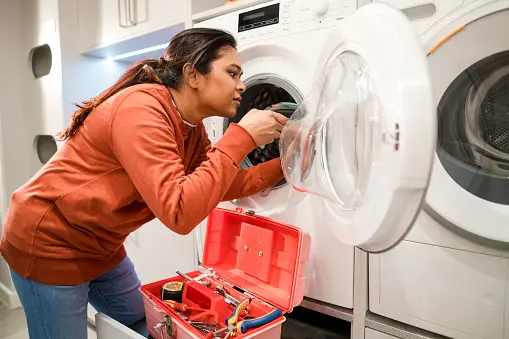Washing machines are important household appliances that make washing tasks easier and more successful. However, like any other machine, they may experience issues over time. Learning these regular issues and how to resolve them can save you time and money. We’ve created a list of the most common washing machine problems and solutions.
What is the Most Common Problem with Washing Machines?
One of the most common problems with washing machines is a difficulty to drain properly. A blocked drain hose, blocked pump, or broken drain pump are common causes of this problem. When water fails to drain properly, it can soak your clothes and cause unpleasant odors.
Solution: First, check the drain tubes for clear clogs or kinks. If the line is clear, test the drain pump for obstructions. You may need to remove any debris or anything that are blocking the pump. If the pump is faulty, it may need to be replaced.
How to Solve a Washing Machine Problem?
Solving washing machine problems typically involves a few steps:
- Identify the Issue: Listen for unusual noises, check for error codes on the display, and observe the machine’s behavior during different cycles.
- Consult the Manual: Refer to your washing machine’s manual for troubleshooting tips and instructions specific to your model.
- Perform Basic Checks: Ensure the machine is properly plugged in, the water supply is turned on, and the door is fully closed.
Tip: Regular maintenance, such as cleaning the lint filter and monitoring the hoses for leaks, can help to avoid many common issues.
How to Reset a Washing Machine?
Resetting a washing machine can often resolve minor glitches or errors. The process can vary depending on the make and model of your machine. Here’s a general method:
- Unplug the Machine: Disconnect the washing machine from the power source.
- Wait: Leave it unplugged for about 1-5 minutes to allow any residual charge to dissipate.
- Plug it Back In: Reconnect the machine to the power source.
- Restart the Cycle: Start a new wash cycle to see if the issue is resolved.
Note: Some models have a specific reset button or a combination of buttons that need to be pressed to reset the machine. Refer to the user manual for detailed instructions.
Why is My Washing Machine Not Filling with Water or Spinning?
If your washing machine isn’t filling with water or spinning, it could be due to several reasons:
- Water Supply Issues: Ensure that the water faucets are turned on and that there are no kinks in the water hoses.
- Door Lock Problems: The machine may not start the cycle if the door isn’t properly closed or if the door lock mechanism is faulty.
- Faulty Water Inlet Valve: The valve that controls water flow into the machine could be malfunctioning.
Solution: Check the water supply and hoses for any problems. Inspect the door lock to ensure it works properly. If the problem is with the water inlet valve, it may need to be cleaned or replaced.
What Causes a Washing Machine Not to Spin and Drain Water?
When a washing machine doesn’t spin or drain water, the problem could be related to:
- Clogged Drain Pump or Hose: Objects or debris may be blocking the pump or hose.
- Lid Switch Assembly: If the lid switch is defective, the machine might not proceed to the spin cycle.
Solution: Examine the drain pump and hose for blockages. Test the lid switch with a multimeter to check for continuity. If the switch is faulty, replace it.
Why is My Washing Machine Spinning Without Water?
A washing machine spinning without water can indicate:
- Faulty Water Inlet Valve: The valve might not be opening to allow water into the drum.
- Electronic Control Board Issues: The control board might not be sending the correct signals to the inlet valve.
Solution: Check the water inlet valve for any issues and replace it if necessary. If the control board is the problem, consult a professional technician for a replacement.
Why is My Washing Machine Running with No Water?
If your washing machine runs a cycle without any water, consider the following:
- Blocked Inlet Screens: The screens in the water inlet valve could be clogged with sediment.
- Defective Water Level Sensor: The sensor that detects water levels might be malfunctioning.
Solution: Clean the inlet screens and ensure water can flow freely. Test the water level sensor and replace it if needed.
What is the Reason if the Washing Machine is Not Taking Water?
When a washing machine is not taking water, the common causes are:
- Clogged Water Inlet Valve: Sediment and debris can block the valve.
- Faulty Water Supply: Ensure the water supply is on and there are no issues with the hoses.
Solution: Clean or replace the water inlet valve. Verify that the water supply is functioning correctly.
Why is My Washing Machine On but Not Spinning?
If your washing machine is on but not spinning, possible reasons include:
- Imbalanced Load: The machine may stop spinning if the load is uneven.
- Drive Belt Issues: A worn or broken drive belt can prevent the drum from spinning.
Solution: Redistribute the clothes to balance the load. Inspect the drive belt and replace it if it’s damaged.
Conclusion
Washing machines can develop faults over time, so understanding common issues and solutions can help maintain their functionality and lifespan. Regular maintenance and timely repairs can prevent costly replacements and simplify laundry tasks. If complex issues arise or require expert assistance, seek professional help.
